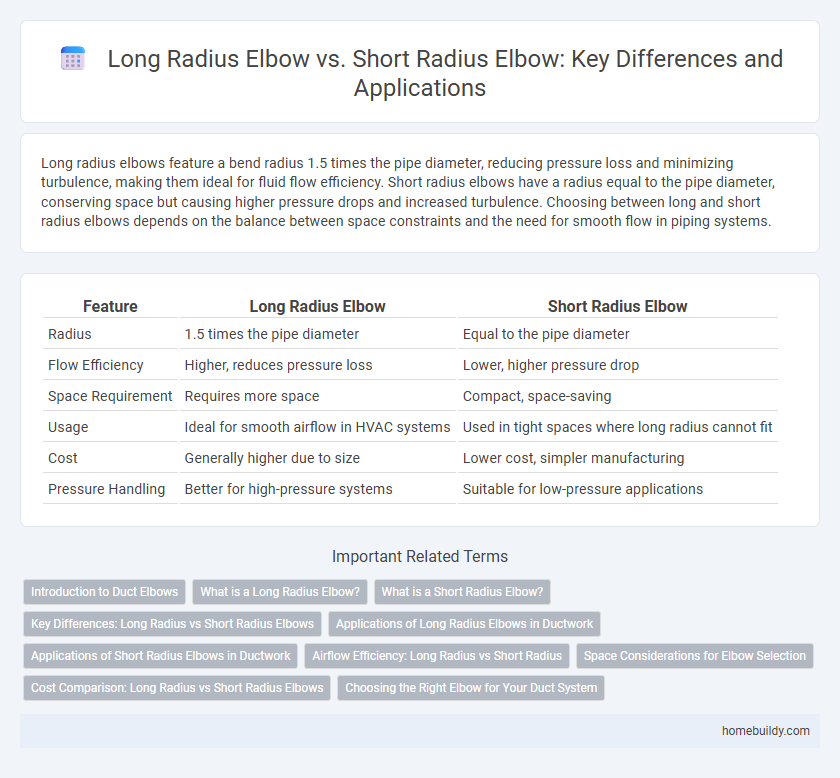Long radius elbows feature a bend radius 1.5 times the pipe diameter, reducing pressure loss and minimizing turbulence, making them ideal for fluid flow efficiency. Short radius elbows have a radius equal to the pipe diameter, conserving space but causing higher pressure drops and increased turbulence. Choosing between long and short radius elbows depends on the balance between space constraints and the need for smooth flow in piping systems.
Table of Comparison
| Feature | Long Radius Elbow | Short Radius Elbow |
|---|---|---|
| Radius | 1.5 times the pipe diameter | Equal to the pipe diameter |
| Flow Efficiency | Higher, reduces pressure loss | Lower, higher pressure drop |
| Space Requirement | Requires more space | Compact, space-saving |
| Usage | Ideal for smooth airflow in HVAC systems | Used in tight spaces where long radius cannot fit |
| Cost | Generally higher due to size | Lower cost, simpler manufacturing |
| Pressure Handling | Better for high-pressure systems | Suitable for low-pressure applications |
Introduction to Duct Elbows
Duct elbows are critical components used to change airflow direction in HVAC systems, typically designed as either long radius or short radius elbows. Long radius elbows provide a gradual turn with a radius 1.5 times the duct diameter, minimizing pressure loss and turbulence for efficient airflow. In contrast, short radius elbows have a radius equal to the duct diameter, offering a compact design but causing higher pressure drops and increased noise levels.
What is a Long Radius Elbow?
A long radius elbow features a centerline radius that is 1.5 times the diameter of the pipe, allowing for a smoother flow with less pressure drop and reduced turbulence. It is commonly used in piping systems where fluid dynamics and minimizing friction losses are critical, such as in water, gas, and chemical transport pipelines. This type of elbow enhances pipeline efficiency and reduces the likelihood of wear and tear compared to short radius elbows, which have a radius equal to the pipe diameter.
What is a Short Radius Elbow?
A short radius elbow features a centerline radius equal to the nominal pipe diameter, resulting in a tighter bend ideal for compact piping systems. This type of elbow is commonly used in situations with limited space where more abrupt directional changes are necessary. Short radius elbows create higher pressure drops and increased turbulence compared to long radius elbows, making them less suitable for high-flow applications.
Key Differences: Long Radius vs Short Radius Elbows
Long radius elbows have a bend radius that is 1.5 times the pipe diameter, which reduces pressure loss and minimizes turbulence, making them suitable for fluid systems requiring smooth flow. Short radius elbows have a bend radius equal to the pipe diameter, resulting in a more compact design but higher pressure drop and increased wear due to sharper turns. The choice between long radius and short radius elbows depends on space constraints, flow efficiency, and system durability requirements.
Applications of Long Radius Elbows in Ductwork
Long radius elbows in ductwork are ideal for applications requiring smooth airflow and minimal pressure drop, such as HVAC systems and industrial ventilation. Their extended curvature reduces turbulence and noise, making them suitable for large ducts carrying air, gases, or dust particles. These elbows are preferred in systems where maintaining airflow efficiency and reducing wear on equipment are critical.
Applications of Short Radius Elbows in Ductwork
Short radius elbows in ductwork are ideal for tight spaces where sharp turns are necessary, such as in compact HVAC systems or confined industrial environments. These elbows facilitate quick directional changes while minimizing space requirements but may cause higher pressure drops compared to long radius elbows. Their compact design makes them suitable for applications requiring efficient use of limited ductwork corridors.
Airflow Efficiency: Long Radius vs Short Radius
Long radius elbows provide superior airflow efficiency by minimizing pressure loss and turbulence within duct systems, making them ideal for HVAC applications requiring smooth air movement. Short radius elbows create sharper turns that increase resistance and reduce airflow efficiency, often causing higher energy consumption and noise. Choosing long radius elbows enhances system performance by maintaining consistent velocity and reducing the risk of airflow separation.
Space Considerations for Elbow Selection
Long radius elbows require more space due to their extended curvature, making them ideal for applications with ample room for smoother fluid flow and reduced pressure loss. Short radius elbows fit into tighter spaces with sharp turns but may cause higher turbulence and increased pressure drop in the piping system. Selecting the appropriate elbow depends on balancing available installation space and desired hydraulic efficiency.
Cost Comparison: Long Radius vs Short Radius Elbows
Long radius elbows generally have a higher initial cost than short radius elbows due to increased material usage and manufacturing complexity. However, their superior flow efficiency can reduce energy consumption and maintenance expenses over time, resulting in lower total lifecycle costs. Short radius elbows may save on upfront expenditure but often incur higher operational costs from increased friction and pressure drops.
Choosing the Right Elbow for Your Duct System
Long radius elbows provide smoother airflow with less pressure loss, making them ideal for HVAC ducts requiring low resistance and quiet operation. Short radius elbows save space and are suitable for compact duct layouts but generate higher turbulence and noise, which might affect system efficiency. Selecting between long and short radius elbows depends on balancing space constraints with airflow performance and noise considerations in your duct system design.
Long radius elbow vs Short radius elbow Infographic

 homebuildy.com
homebuildy.com